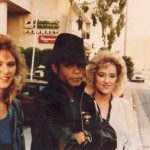 When we think of inter-group relations, we might think our job, friends, or what we see on television. When I think inter-group relations, I automatically go back to high school. What better place to pull examples of prejudice, discrimination, social identity theory, and social dominance theory. It is all here under one roof, now keep in mind when I was in high school it was the height of the 1980’s and fashion played an important role in the a fore mentioned theories that we will discuss.
When we think of inter-group relations, we might think our job, friends, or what we see on television. When I think inter-group relations, I automatically go back to high school. What better place to pull examples of prejudice, discrimination, social identity theory, and social dominance theory. It is all here under one roof, now keep in mind when I was in high school it was the height of the 1980’s and fashion played an important role in the a fore mentioned theories that we will discuss.
Let us start with inter-group relations that tell us that we size a person up when we meet them. Evolutionary psychologists say that our ancestors used this theory to see if they would welcome a stranger into the tribe. They based this on eye and skin color and similarities to themselves. This served a purpose as to keep diseases that would wipe the tribe out (Applying Social Psychology to Diversity, 2012). This practice was still being used in my high school with the same foundation as our ancestors. When a new student would show up to school, they were instantly sized up, first by what they wore, such as Espree, Polo, Swatch, etc. Secondly, their social skills were observed. Finally, their demographics were looked at such as how much money their parents had and what kind of car they drove. Once this assessment was done, the new person was placed in a group and the other groups treated like you did not even exist. You really had no choice at our school in these matters. Therefore, we can see that appearances were very important much as they were to our ancestors. This leads us to prejudice and discrimination.
The definition of prejudice given to us by Webster’s dictionary is an injury or damage resulting from judgment or action of another in disregard of ones rights. In our high school, there were only two students of non-white descent. They were treated fairly  but were not included in any of the groups in the social hierarchy, nor were they ever invited to any social gatherings. The definition of discrimination given to us by Webster’s dictionary is the practice of unfairly treating a person or group of people differently from other people or groups of people. For my high school, this meant the groups in which you did not belong discriminated against you and the lines of social hierarchy were rarely crossed.
but were not included in any of the groups in the social hierarchy, nor were they ever invited to any social gatherings. The definition of discrimination given to us by Webster’s dictionary is the practice of unfairly treating a person or group of people differently from other people or groups of people. For my high school, this meant the groups in which you did not belong discriminated against you and the lines of social hierarchy were rarely crossed.
Allport (1954) argued “that people put together and working to a mutual goal would form a bond or reduce tensions between groups” (Applying Social Psychology to Diversity, 2012). I am afraid that he would have been poorly disappointed in our school. We were placed in classes together and had to work together toward an academic goal but no bond was formed. In extracurricular activities, a show was put on for others that we were getting along but boundaries remained untouched. Therefore, for Gordon’s hypothesis it failed like a cement balloon at our school.
What does Social Identity Theory mean? It means that we act one way when we are in a certain group or environment than when we are alone. An example of this is, when in school we all put up a front to be the person that our groups want us to be. One of my close friends, when she was alone, liked to not wear makeup and lounge around in sweat pants and read, but in our school setting, she played the pretty, silly, typical blonde cheerleader. For myself when I was in high school I was in the closet and maintained the illusion of being straight by dating many girls in high school so that my social group would not ostracize me. Within Social Identity Theory, there is the idea of personal identity and social identity.
Personal identity is simply defined as “the factors such as age, race, and sex that places us into groups” (Brewer & Gardner, 1996). It also involves “characteristics of people so the bio-social markers also create a personal identity including also all of the aspects of the self that are unique to the individual and which are used to define the  individual” (Brewer & Gardner, 1996). The best way to match this with an example from our school would be the athletic department. If you were a guy with skills, football would be the top choice, basketball would be the second choice and therefore classified as a “jock” and looked up to by the school to put us on the high school map. If you were
individual” (Brewer & Gardner, 1996). The best way to match this with an example from our school would be the athletic department. If you were a guy with skills, football would be the top choice, basketball would be the second choice and therefore classified as a “jock” and looked up to by the school to put us on the high school map. If you were  a girl who was peppy and flexible, you would try out for the cheerleaders, and if you were very pretty and flexible, you tried out for the school dance team, which was considered a higher social status than cheerleader was. Both groups were considered athletic but designed for the different sexes and talents of the students.
a girl who was peppy and flexible, you would try out for the cheerleaders, and if you were very pretty and flexible, you tried out for the school dance team, which was considered a higher social status than cheerleader was. Both groups were considered athletic but designed for the different sexes and talents of the students.
Social identity as translated by my classmates and myself is what group you belong to, defined who you were. If you were popular and beautiful, you ruled the school. If you were athletic you gave pride to the school, however if you stood on the sidelines and did not wear what was in style you were considered an outcast. Now the groups have grown to encompass many other types therefore creating a more diverse selection of groupings. For us we had the less complex groupings, such as jocks, nerds, and popular kids.
The last theory to be discussed is the Social Dominance Theory. What this means is that there is an indication that “society is arranged by a system of group based hierarchies and that people within those groups are typically motivated to behave in ways that maintain these hierarchies” (Pratto, Sidnaius, & Levin, 2006; Sidnaius &  Pratto, 1999). In our school this defined the hierarchy as the “popular” and their duty was to maintain the popular borders of the school and all lower social structures within the school. A good quote that comes to mind for this comes from “The Fellowship of the Rings” when Gandalf says, “You Shall Not Pass!”
Pratto, 1999). In our school this defined the hierarchy as the “popular” and their duty was to maintain the popular borders of the school and all lower social structures within the school. A good quote that comes to mind for this comes from “The Fellowship of the Rings” when Gandalf says, “You Shall Not Pass!”
Some of you might think our school was mean and unjust, but it was the 1980’s at a private school in Utah and things were done differently and we dealt with it. Things are better but the social structure of inter-group relations is still at work on high school campuses all over. These types of structures will always be in existence at high schools, however it is our job to help teach the younger generations to be proud of whom they are and not allow themselves to put into a mold and conform to the social norms.
References
Allport, G.W. (1954). The nature of prejudice. Reading, MA: Addison-Wesley.
Applying Social Psychology to Diversity. (2012). In F. Schneider, J. Gruman, & L. Coutts (Eds.),Applied social psychology: Understanding and addressing social and practical problems(2nd ed.). Los Angeles: Sage.
Brewer, M., & Gardner, W. (1996). Who is this “we”? Levels of collective identity and self-representations. Journal of Personality and Social Psychology, 71, 83-93.
Pratto, F., Sidanius, J., & Levin, S. (2006). Social dominance theory and the dynamics of intergroup relations: Taking stock and looking forward. European Review of Social Psychology, 17, 271-320.
Sidanius, J., & Pratto, F. (1999). Social dominance: An intergroup theory of social hierarchy and oppression. New York: Cambridge University Press.

It was interesting to read about inter-group relations in this perspective and it forced me to look back to my high school days (which wasn’t that long ago considering I graduated in 2010). Unfortunately not much as changed since I experienced all of the concepts of inter-group relations and conflicts during my time. We had our “cliques” that seemed to rule the school and there definitely was a social hierarchy due to this. Even though I miss the environment and being able to fill my mind with information on a daily basis, I do not miss the people and the conflicts that were often present from day to day.